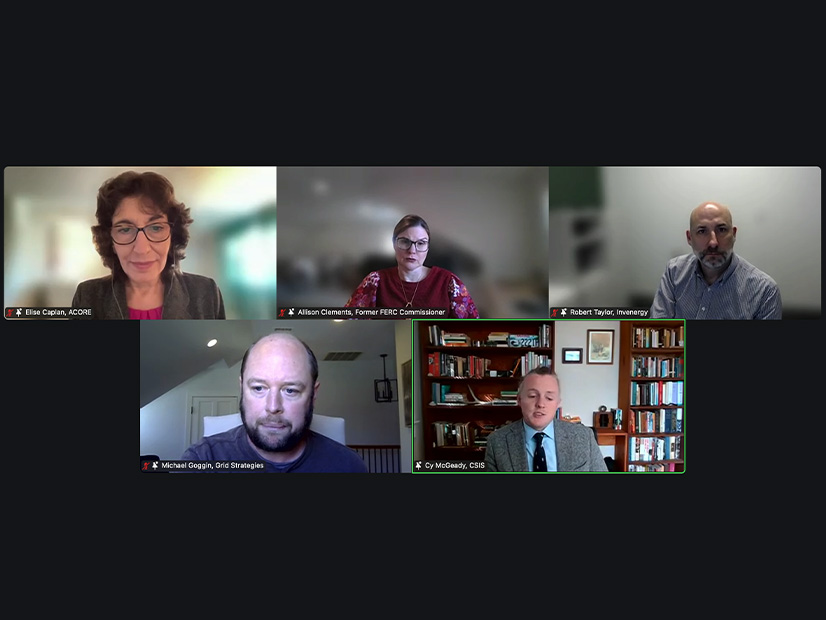
NERC’s recently submitted Interregional Transfer Capability Study (ITCS) is “a phenomenal first step,” according to participants in a webinar hosted by the American Council on Renewable Energy and Americans for a Clean Energy Grid — but there’s still much work ahead to address the U.S. grid’s mounting reliability challenges.
Speakers at the Nov. 25 webinar included former FERC Commissioner Allison Clements; Robert Taylor, vice president for transmission and new markets at Invenergy; Michael Goggin, vice president at Grid Strategies; and Cy McGeady, a fellow for energy security and climate change at the Center for Strategic and International Studies (CSIS). ACORE and ACEG hosted the forum to discuss the implications of the ITCS and potential future steps for FERC, Congress and other stakeholders.
NERC filed the ITCS with FERC Nov. 19, ahead of the December deadline for the study set by Congress in the Fiscal Responsibility Act of 2023. (See NERC Files ITCS to FERC, Meeting Congress’ Deadline.)
The ERO worked with the regional entities and transmitting utilities for 18 months to develop the three-part report, which FERC will now post for public comment. A final installment focused on transmission between the U.S. and Canada, and between Canada’s provinces, is planned to be released in early 2025.
In the ITCS, NERC recommended 35 GW of additional transfer capability across transmission planning regions in North America to strengthen grid reliability, including two new connections between ERCOT and neighboring regions. (See NERC Releases Final ITCS Draft Installments.) The report’s authors emphasized the analysis did not account for economic issues and cost-benefit analysis, and that even with the recommended additions it would not be possible to resolve all energy deficiencies due to chronic “wide-area resource shortages.”
In ACORE’s webinar, McGeady called the ITCS an “excellent starting point” and a “baseline” for future studies. Similarly, Goggin said NERC and its collaborators “did a great job in really tight time constraints and with the pretty narrow scope that Congress gave them.”
At the same time, attendees said the narrow scope meant that NERC ended up performing a conservative analysis. Goggin said the 35 GW recommendation represents “a floor, in my view, of what you should be thinking about in terms of an optimal transmission expansion.” He noted that FERC only tasked the ERO with identifying “prudent” transmission additions to improve reliability, which meant the study understandably did not take some important factors into consideration.
“Basically, it’s just keeping the lights on. It’s not looking at the opportunity to reduce consumer costs by giving them cheaper power,” Goggin said. “More importantly, even on the resource adequacy side, it’s not looking at how transmission can help you share generating capacity. … The NERC study did look at this, but they didn’t look at how you could economically save on building power plant capacity by tapping into” neighboring regions’ generation.
McGeady added that the figures NERC used to estimate demand were based on the ERO’s 2023 Long-Term Reliability Assessment. He said the projections in this year’s LTRA were likely to be “profoundly larger, like significantly upward revisions.” This means the ITCS’ recommendations could turn out to be even more conservative than Goggin and other panelists thought.
Moderator Elise Caplan of ACORE suggested these concerns could be taken up by respondents when FERC opens comments on the study, along with how to meet the additional unmet needs that NERC identified.
Asked what actions FERC could take to improve reliability through interregional transmission ties, Clements said she believes the commission can play a significant role. She called on FERC to take the lead on interregional planning and on the cost allocation process.
“I think if you’re really, genuinely trying to get to reliability at this moment in time, across the systems that constitute this nation’s electricity systems, we need to be looking at all the tools in the toolbox,” Clements said. “When it comes to reliability, there’s often a quick jump to say you can’t retire the uneconomic thermal units that want to retire. … I think it’s imperative on the commission to say what are the quick, easy, fast ways to do that.”
“I wasn’t a champion of transmission just because I think transmission is great. In fact, it would be a lot easier if we didn’t have to build it,” Clements added. “I’m a champion of transmission because it is a way to get to cost-effective reliability for customers.”
